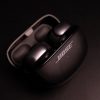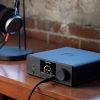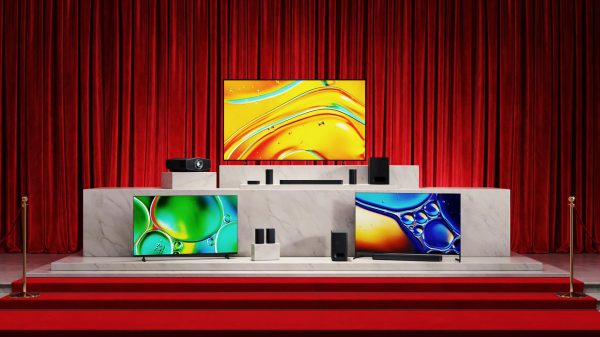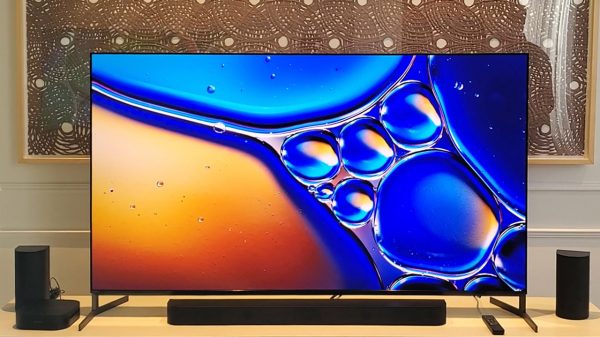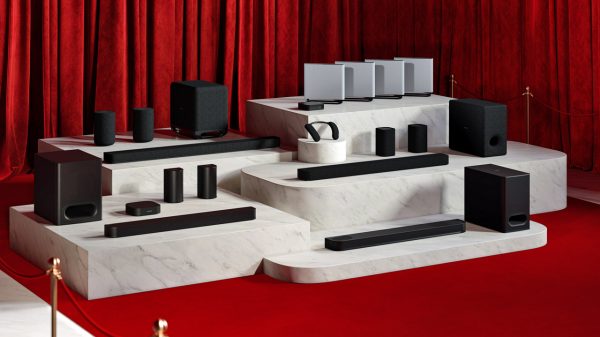iFi Audio is a British audio technology company which produces a variety of equipment to help boost one’s overall listening experience. They are particularly focussed on portable audio gear, offering various dongle DACs, and portable amplifiers that can be carried around for listening to music and other media on the go.
iFi cater to everyone, from the ultra cost-conscious music enjoyer to the most demanding of audiophiles and everything in between, even in the portable audio space. Today, we will be looking at the latter end of the spectrum with the GO bar Kensei, a dongle DAC retailing at $449 USD. It is an upgraded variant of the original GO bar with additional features and a rather unique build.

Specifications & Technology
Boasting almost half a watt of power out of its balanced connection (477mW @ 32 Ohms), the GO bar Kensei certainly packs a punch. The single-ended 3.5mm output jack delivers 300mW @ 32 Ohms.
On the audio processing side of things, the iFi uses a 16-core XMOS microcontroller combined with a 32-bit Cirrus Logic DAC chipset. These are high-end discrete components.
The DAC allows up to 32-bit/384kHz PCM, Native DSD256, 2x DXD and full MQA decoding to boot.
iFi claim that the Kensei can be used with power-hungry full-size headphones as well as ultra-sensitive in-ear monitors thanks to its inclusion of a Turbo Mode and IEMatch respectively. Whether this is the case will be discussed in the “listening” section of the review.
As is typical of iFi, the product also features multiple sound tuning options which are baked in. XBass+ and XSpace do what they say on the tin, but the Kensei has a brand-new option never seen before on any other product, K2HD.
Developed together with JVCKENWOOD, K2HD is believed to “revive rich, natural harmonics in digital sound, adding an organic quality that breathes life into recordings.” It does this by enhancing overtones above 22kHz, supposedly bringing the music closer to the original recording. Clever stuff, but does it actually work?
There’s also four digital filters (Standard, Bit-Perfect, Minimum Phase, GTO). Despite iFi’s marketing, these filters do not make a substantial difference to the sound in my opinion.
As we have come to expect from most DAC and amplifier manufacturers these days, Signal-to-Noise Ratio and Total Harmonic Distortion figures are excellent, with values well below the audible ranges to worry about.

Design & Build
“Kensei” means “sword master” in Japanese, and the influence on the industrial design of the DAC/headphone amplifier is rather striking.
Japanese stainless steel makes up the bulk of the dongle’s construction, and the device comes stored in a beautifully crafted bamboo box with traditional engravings. Immediately you know you’re getting a pretty special item here. Considering you are paying a hefty premium over the regular GO bar, which retailed for $329, it should be expected that the design, build quality and performance are superior.
Some useful accessories are provided, being a soft black leather case and two adapters, one for USB-A and the other for lightning to use on some Apple devices. The device otherwise connects on both ends via a USB Type-C connector.
On one side of the GO bar Kensei are a trio of physical buttons, two for volume and a third for changing sound profiles. On the same side is a toggle for utilising IEMatch. Finally, on the bottom of the device is a system of colored LEDs which help specify bit rate and chosen sound profiles. I found this to be very simple and intuitive.
Two headphone jacks are provided, a 4.4mm balanced connection for maximum power output and a slightly less powerful 3.5mm “S-Balanced” output.
Despite having all these features and an all-metal build, the Kensei only weighs 65 grams, is a touch larger than a regular USB drive (2.6″ x 0.9″ x 0.5”) and thus easily fits in most pockets.
Overall, the little iFi has a solid and sturdy feel that gives confidence it won’t break. It feels decidedly premium, but the $450 USD asking price sets the bar rather high from a performance perspective.

Performance & Synergy
Listening impressions were complied by connecting the GO bar Kensei via USB-C to a laptop and Android phone. A varied selection of full-sized headphones were plugged into the dongle DAC via its 4.4mm balanced output, including the HiFiMAN Arya Unveiled, Audio-Technica ATH-R70x and HiFiMAN HE6se V2. A mixture of local FLAC files and Spotify streams were listened to.
Worth noting before we dig into the sound quality, the Go bar Kensei definitely draws a lot of power from an unplugged device. My phone usually lasts around 8-10 hours on a single charge, but when using it with the Kensei plugged into its USB-C port, battery life dropped significantly to around 3 hours. Just something to bare in mind if you intend to use the iFi on the go; it may be best to bring a portable charger with you as well.
Despite not using the famed Burr-Brown DAC chipset that iFi uses on many of its other products, the GO bar Kensei retains the warm-leaning sound profile that the British audio company is renowned for.
Starting with the bass, I found it to be incredibly impactful, extending deep into the sub bass thanks to the high power output of the GO bar Kensei. The Beatles’ “Come Together” starts with a strong bass line and the GO bar Kensei delivered solid impact and definition right off the bat.
The midrange is smooth and refined, with no particular part of the midrange elevated above the rest. Vocals and instrumentation were delivered with timbral accuracy and male voices were not pushed forward of the rest of the mix.
Moving onto treble, it is certainly very detailed and well defined, but also toned down slightly compared to the bass and midrange. This is what gives the Kensei its overall warm tonal balance. You notice this when listening to L’Impératrice’s “La lune,” where the high-pitch sounds of the triangle aren’t quite as emphasised as I’m used to on most other solid-state devices. Instead, the focus is shifted towards the bass guitar, which hits hard thanks to the focus on lower frequencies.
Soundstaging and imaging is superb for a portable device, rivalling similarly-priced desktop DAC/amps including iFi’s own ZEN DAC 3. It will not turn a pair of closed back dynamic headphones into a pair of open-back planars in either the vertical or horizontal plane, but the imaging within the decent-sized stage is pinpoint accurate.
I usually steer clear of sound filters or anything that alters the sound of an amplifier or DAC in any way. Surely a product should just sound good out of the box, with no need to play around until you find a profile that you like? But iFi’s system of filters and proprietary technology is tastefully done and each offers a unique but totally inoffensive listening experience, that you can’t help but mess around with the myriad of options available to you.
One filter that was always on was K2HD, because it made a tangible difference to audio quality with no perceivable drawbacks. All of my listening impressions were made with K2HD processing active. While the GO bar Kensei sounds excellent in its own right, K2HD added a sense of realism and naturalness to the sound by subtly tweaking timbre, while improving clarity and imaging focus at the same time. I’m really not sure how they’ve achieved it; hats off to JVCKENWOOD and iFi.
Briefly touching on the other sound profiles, XBass+ bumps up the lower frequencies by a few dB, maybe around five or so. It does encroach into the midbass slightly so be careful with headphones that already have an emphasis on this area of the spectrum.
XSpace certainly results in a perceived widening of the soundstage, and I sense this is done by elevating the upper midrange and upper treble frequencies. If your headphones are already bright-leaning, toggling XSpace might make them too fatiguing for you.
The GO bar Kensei is able to power the vast majority of full-sized headphones. Of course, the HE6se V2 is a bit of an outlier, and unfortunately the little dongle DAC doesn’t have enough juice to power it without making it sound anaemic and harsh in the treble.
The Kensei does have an incredibly black audio background; while I wasn’t able to test it with IEMs I can imagine it will have no issues with sensitive in-ear monitors, especially with IEMatch turned on.

The Bottom Line
The dongle DAC market has an abundance of options in 2025 and manufacturers are struggling somewhat to differentiate their products from the competition. The $450 asking price is on the higher side but the iFi GO bar Kensei looks and genuinely feels different and far more luxurious – it is a unique design that attracts attention.
But its the K2HD processing that makes the Kensei worth its price hike over the original GO bar, adding a palpable sense of realism and strong dynamic capabilities that are unique in the category.
iFi hit a home run with the GO bar Kensei and we hope to see the K2HD technology used again in other products.
Pros:
- Sturdy, luxurious build
- Class-leading, desktop-worthy sound quality
- Support for native DSD and 32-bit/384kHz PCM
- Balanced output can drive a mix of planar and dynamic headphones rather well
Cons:
- Warm sonic signature not for everyone
- Expensive
Where to Buy:
Related Reading:


